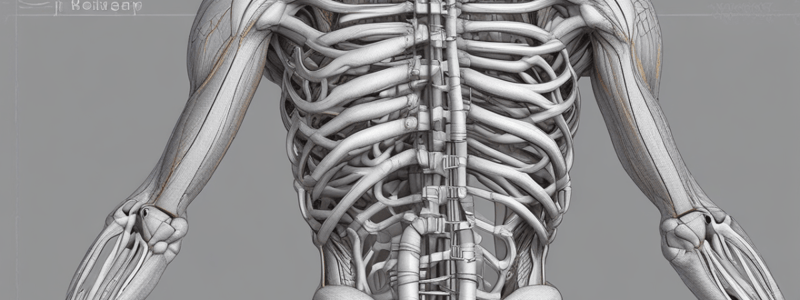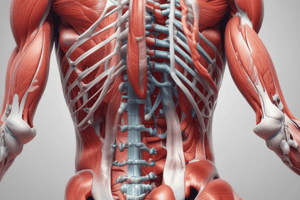Podcast
Questions and Answers
What is the primary source of ATP for glycolytic fibers?
What is the primary source of ATP for glycolytic fibers?
- Aerobic respiration
- Oxidative phosphorylation
- Mitochondrial activity
- Glycolysis (correct)
What is the function of myoglobin in oxidative fibers?
What is the function of myoglobin in oxidative fibers?
- To slow down muscle contractions
- To facilitate glycolysis
- To store oxygen (correct)
- To release ATP
Which type of fiber has a larger diameter and less myoglobin?
Which type of fiber has a larger diameter and less myoglobin?
- Oxidative fiber
- Fast-twitch fiber
- Slow-twitch fiber
- Glycolytic fiber (correct)
What is the characteristic of fast-twitch fibers in terms of muscle contractions?
What is the characteristic of fast-twitch fibers in terms of muscle contractions?
What is the main difference between oxidative and glycolytic fibers in terms of energy supply?
What is the main difference between oxidative and glycolytic fibers in terms of energy supply?
Which type of meat is composed of glycolytic fibers?
Which type of meat is composed of glycolytic fibers?
What is the main difference between slow-twitch and fast-twitch fibers in terms of contraction speed?
What is the main difference between slow-twitch and fast-twitch fibers in terms of contraction speed?
What type of fibers are exclusively found in the muscles of the eye and hand?
What type of fibers are exclusively found in the muscles of the eye and hand?
What happens to some fast glycolytic fibers when a muscle is used repeatedly for activities requiring high endurance?
What happens to some fast glycolytic fibers when a muscle is used repeatedly for activities requiring high endurance?
What is unique about the muscles surrounding the gas-filled swim bladder of the male toadfish?
What is unique about the muscles surrounding the gas-filled swim bladder of the male toadfish?
What is the main difference between vertebrate cardiac muscle and skeletal muscle?
What is the main difference between vertebrate cardiac muscle and skeletal muscle?
What is the purpose of intercalated disks in vertebrate cardiac muscle?
What is the purpose of intercalated disks in vertebrate cardiac muscle?
What is a characteristic of smooth muscle cells in vertebrates?
What is a characteristic of smooth muscle cells in vertebrates?
How do smooth muscle cells regulate contraction?
How do smooth muscle cells regulate contraction?
What is a difference between smooth muscle and striated muscle?
What is a difference between smooth muscle and striated muscle?
What is a function of dense bodies in smooth muscle cells?
What is a function of dense bodies in smooth muscle cells?
What is the primary function of myoglobin in oxidative fibers?
What is the primary function of myoglobin in oxidative fibers?
What is the main difference between oxidative and glycolytic fibers in terms of their structure?
What is the main difference between oxidative and glycolytic fibers in terms of their structure?
Which type of fibers are specialized for brief, rapid, and powerful contractions?
Which type of fibers are specialized for brief, rapid, and powerful contractions?
What is the role of many mitochondria in oxidative fibers?
What is the role of many mitochondria in oxidative fibers?
What is the characteristic of dark meat in poultry and fish?
What is the characteristic of dark meat in poultry and fish?
Which type of fibers are more prone to fatigue?
Which type of fibers are more prone to fatigue?
What is the reason for the difference in contraction speed between slow-twitch and fast-twitch fibers?
What is the reason for the difference in contraction speed between slow-twitch and fast-twitch fibers?
What is the characteristic of cardiac muscle cells that allows them to initiate rhythmic depolarization and contraction?
What is the characteristic of cardiac muscle cells that allows them to initiate rhythmic depolarization and contraction?
What is the function of Ca2+ in smooth muscle cells?
What is the function of Ca2+ in smooth muscle cells?
What is the difference in the way Ca2+ regulates contraction in smooth muscle cells compared to striated muscle cells?
What is the difference in the way Ca2+ regulates contraction in smooth muscle cells compared to striated muscle cells?
What is the result of repeated use of a muscle for activities requiring high endurance?
What is the result of repeated use of a muscle for activities requiring high endurance?
What is unique about the muscles surrounding the gas-filled swim bladder of the male toadfish?
What is unique about the muscles surrounding the gas-filled swim bladder of the male toadfish?
What is the function of dense bodies in smooth muscle cells?
What is the function of dense bodies in smooth muscle cells?
What is the primary difference between skeletal muscle and cardiac muscle?
What is the primary difference between skeletal muscle and cardiac muscle?
What is the difference in the contraction speed between slow-twitch and fast-twitch fibers?
What is the difference in the contraction speed between slow-twitch and fast-twitch fibers?
What is the characteristic of smooth muscle cells that allows them to contract and relax more slowly than striated muscle cells?
What is the characteristic of smooth muscle cells that allows them to contract and relax more slowly than striated muscle cells?
Flashcards are hidden until you start studying
Study Notes
Types of Skeletal Muscle Fibers
- Skeletal muscle fibers are classified based on ATP sources and contraction speed.
- Oxidative Fibers: Rely primarily on aerobic respiration, characterized by:
- High number of mitochondria for energy production.
- Rich blood supply to facilitate oxygen delivery.
- Significant amounts of myoglobin, which binds oxygen tightly, enabling efficient oxygen extraction from blood.
- Glycolytic Fibers: Predominantly use glycolysis for ATP, featuring:
- Larger diameter and lower myoglobin content.
- Faster fatigue compared to oxidative fibers.
- Visible distinction in meat: dark meat (oxidative fibers) versus light meat (glycolytic fibers) in poultry and fish.
Fast-Twitch and Slow-Twitch Fibers
- Fast-Twitch Fibers:
- Contract faster, developing tension 2-3 times quicker than slow-twitch fibers.
- Allow for brief, powerful contractions.
- Can be glycolytic or oxidative.
- Slow-Twitch Fibers:
- Have less sarcoplasmic reticulum and slow Ca2+ pumping, resulting in longer muscle twitches (up to five times longer than fast-twitch fibers).
- All slow-twitch fibers are oxidative.
- Human skeletal muscles contain mixed types, with muscles in the eye and hand being exclusively fast-twitch.
- Genetic factors determine the relative composition of fast and slow fibers in a muscle.
- With repeated endurance training, some fast glycolytic fibers may convert to fast oxidative fibers, increasing resistance to fatigue.
Specialized Muscle Fibers
- Superfast muscle fibers found in certain vertebrates produce rapid movements, such as:
- The rattlesnake's rattle and dove's coo.
- Male toadfish muscles can contract over 200 times per second to produce a mating call.
Other Types of Muscle
- Cardiac Muscle:
- Striated, found only in the heart.
- Can spontaneously initiate contractions without neural input.
- Action potentials in cardiac cells are longer (up to 20 times longer than skeletal muscle).
- Intercalated disks electrically couple cardiac muscle cells, allowing synchronized contraction.
- Smooth Muscle:
- Found in hollow organs (e.g., blood vessels, digestive tract).
- Lacks striations; actin and myosin are scattered, not regularly arranged.
- Can contract in response to autonomic nervous system stimulation or autonomously through electrical coupling.
- Contractions are slower than striated muscles, regulated by calcium ions interacting with calmodulin instead of a troponin complex.
Studying That Suits You
Use AI to generate personalized quizzes and flashcards to suit your learning preferences.




